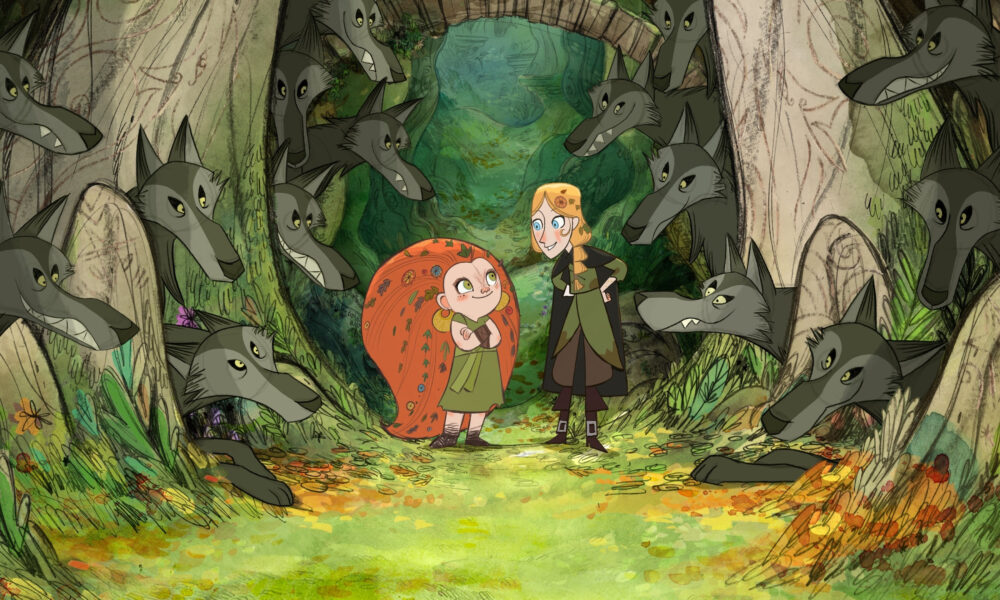In a streaming era saturated with live-action, CGI, and 3D animated films, lately, all I’ve wanted to do is curl up under a blanket and watch a 2D animated movie. The other day, while scrolling through Letterboxd lists, I stumbled upon a movie I had never heard of before: Wolfwalkers. I wasn’t surprised that I hadn’t seen it. It’s a movie from an independent Irish animation studio called Cartoon Saloon, and although nominated for an Academy Award in 2021 for Best Animated Feature, it held onto a niche rarely seen in recent animated feature films: Pure, 2D animation.
Now don’t come after me. I know that the latest recipient of the Oscar for Best Animated Feature, The Boy and the Heron, is also (technically) 2D animation. Animators indeed created the movie using 2D animation tactics—hand-drawn frames and a vector-based style, to name a few. But, like in other Studio Ghibli films, the directors used computer animation to incorporate specific effects in moving the frames from paper to screen. And that’s not a bad thing. That’s not my point.
My point is that I wanted to watch a movie that is beautiful in its simplicity. I want to watch more movies that don’t try to hide the hand-drawn labour of love that is an animator crafting individual frames to make up seconds of a movie that spans over an hour. I watched Wolfwalkers in a trance, enthralled by the gesture lines of the wolves and the colouring outside of the lines. The film is clearly inspired by Celtic artwork and mythology—exuding a timeless feel that makes the story appear modern despite its 17th-century Irish setting. 2D imbues the movie with magic and whimsy and childhood and so many more things that I don’t believe would have come across in the same way if it was created using 3D animation. It made me feel hopeful.
2D animation has come a long way since its inception. Most people credit Émile Cohl’s Fantasmagorie (1908) as the first animated “film” or cartoon. It’s rough, sure, but the minute of nearly 700 fluid, hand-drawn frames paved the way for celluloid “cel” animation in Snow White and the Seven Dwarves (1937), where artists drew onto transparent cels that could be laid on top of different backgrounds. These techniques helped develop limited animation, where common actions (think a character walking) could be reused. Each technique development aimed to save money, reduce the amount of individual frames an artist had to produce, and ultimately achieve a more fluid look.
With every technological advancement comes an expectation to conform. It’s true, 3D and CGI have made great progress since their beginnings in the 1960s and ’70s. It’s easier than ever to use 3D rigs to create cohesive images of a character, rather than follow an individual 2D animator’s stylistic guide. And yes, 3D models—specifically thanks to Disney and Pixar—have made it possible to create realistic characteristics with a variety of different hair types, increasing onscreen diversity. But in 2D animation, you know that each animator has put in the time and effort to truly master the character that they aim to produce on film. It is their pen on paper—or stylus on screen, whatever they use—that crafts each face, hair follicle, line, and colour.
I know a lot of people love 3D animation—I do too. But I encourage people to dive into the beauty of 2D animation and experience it with an open mind. 3D animation might be exciting, but 2D has just as much capability to create flashy and interesting visual stories. Not every movie is like Wolfwalkers with its intentionally rough style. Watch Persepolis for a gorgeous black and white comic style. Or La tortue rouge (The Red Turtle) for a dialogue-free film highlighting lush natural landscapes. 2D animation is capable of being a vessel for diverse art styles—if we only give it a chance.








